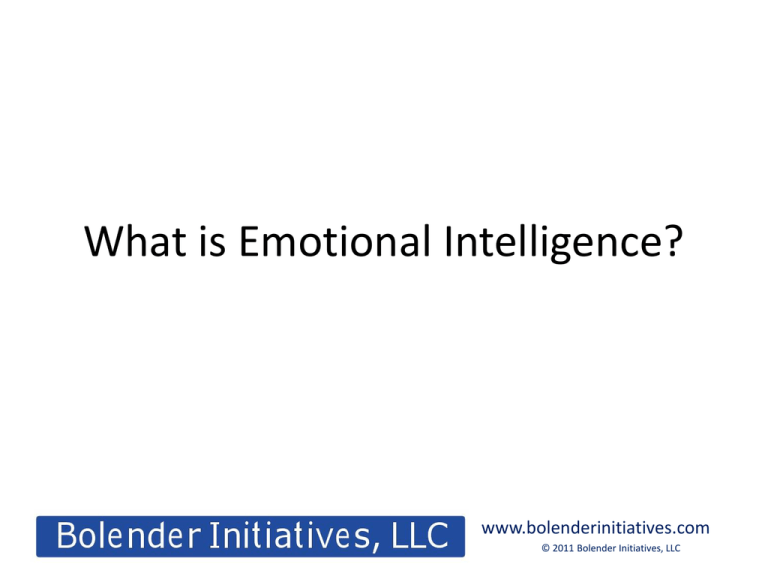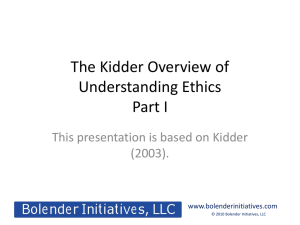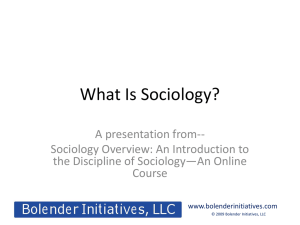
What is Emotional Intelligence?
www.bolenderinitiatives.com
© 2011 Bolender Initiatives, LLC
People who know their own emotions
and are good at reading others' emotions
may be more effective in their jobs.
(Robbins & Judge, 2008, p. 116)
www.bolenderinitiatives.com
© 2011 Bolender Initiatives, LLC
Emotional intelligence helps promote effective functioning and
well-being among employees. People differ in terms of the
extent to which they know how they, themselves, are feeling,
why they are feeling that way, and their ability to manage
those feelings. Similarly, they differ in their ability to
understand what other people are feeling and why, and their
ability to influence or manage the feelings of others.
Emotional intelligence describes these individual differences
(George & Jones, 2008, pp. 59-60; Goleman, 1995).
www.bolenderinitiatives.com
© 2011 Bolender Initiatives, LLC
Emotional intelligence (the acronyms EQ or EI are used--either is
acceptable) is ones ability to detect and manage emotional
cues and information. Emotional intelligence is composed of
five dimensions (Goleman, 2004, p. 88).
www.bolenderinitiatives.com
© 2011 Bolender Initiatives, LLC
The Five Dimensions of EI
• Self-Awareness: the ability to recognize and understand your moods,
emotions, and drives, as well as their effect on others.
• Self-Regulation: the ability to control or redirect disruptive impulses and
moods; the propensity to suspend judgment--to think before acting.
• Motivation: a passion to work for reasons that go beyond money or
status; a propensity to pursue goals with energy and persistence.
• Empathy: the ability to understand the emotional makeup of other
people; skill in treating people according to their emotional reactions.
• Social Skill: proficiency in managing relationships and building networks;
an ability to find common ground and build rapport.
www.bolenderinitiatives.com
© 2011 Bolender Initiatives, LLC
Self-Awareness
• Self-Awareness: the ability to recognize and understand your
moods, emotions, and drives, as well as their effect on others
(Goleman, 2004, p. 88). The following are key indicators of
self-awareness.
– Self-confidence
– Realistic self-assessment
– Self-deprecating sense of humor
www.bolenderinitiatives.com
© 2011 Bolender Initiatives, LLC
Self-Awareness
• Self-awareness is the basis for the other components of
emotional intelligence. It refers to a person's capacity for
being aware of how they are feeling. In general, more selfawareness allows a person to more effectively guide their
own lives and behaviors (Griffin & Moorhead, 2007, p. 65).
www.bolenderinitiatives.com
© 2011 Bolender Initiatives, LLC
Self-Awareness
• Being aware of emotions requires reflection. If one learns
to pause, to focus inward, and to seek ones emotions, one
can become more aware of them. You might begin asking
yourself several times during a normal day, "What am I
feeling now?" If you question yourself frequently for a
week, you will probably be able to notice what you feel
more readily. Then the challenge--one accepted by people
with high emotional intelligence--is to manage those
emotions in a more positive way. People who develop a
high emotional intelligence do not yield to their emotions
easily--rather they seek to manage them (Clawson, 2009, p.
176).
www.bolenderinitiatives.com
© 2011 Bolender Initiatives, LLC
Self-Awareness in Practice
• Emotional awareness: Recognizing ones emotions and their
effects. People with this competence:
– Know which emotions they are feeling and why
– Recognize how their feelings affect their performance
– Have a guiding awareness of their values and goals
• Accurate self-assessment: Knowing ones strengths and limits.
People with this competence:
– Aware of their strengths and weaknesses
– Reflective, learning from experience
– Open to candid feedback, new perspectives, continuous learning, and selfdevelopment
– Able to show a sense of humor and perspective about themselves
www.bolenderinitiatives.com
© 2011 Bolender Initiatives, LLC
Self-Awareness in Practice
• Self-confidence: Sureness about ones self-worth and
capabilities. People with this competence:
– Present themselves with self-assurance; have "presence"
– Can voice views that are unpopular and go out on a limb for what is
right
– Are decisive, able to make sound decisions despite uncertainties and
pressures
www.bolenderinitiatives.com
© 2011 Bolender Initiatives, LLC
Self-Regulation
• Self-Regulation: the ability to control or redirect disruptive
impulses and moods; the propensity to suspend judgment--to
think before acting (Goleman, 2004, p. 88). The following are
key indicators of self-regulation.
– Trustworthiness and integrity
– Comfort with ambiguity
– Openness to change
www.bolenderinitiatives.com
© 2011 Bolender Initiatives, LLC
Self-Regulation
• Self-regulation refers to a person's capacity to balance
anxiety, fear, and anger so that they do not overly interfere
with getting things accomplished (Griffin & Moorhead, 2007,
p. 65).
www.bolenderinitiatives.com
© 2011 Bolender Initiatives, LLC
Self-Regulation in Practice
• Self-control: Managing disruptive emotions and
impulses. People with this competence:
– Manage their impulsive feelings and distressing emotions well
– Stay composed, positive, and unflappable even in trying moments.
– Think clearly and stay focused under pressure
• Trustworthiness: Maintaining standards of honesty and
integrity. People with this competence:
–
–
–
–
Act ethically and are above reproach
Build trust through reliability and authenticity
Admit their own mistakes and confront unethical actions in others
Take tough, principled stands even if they are unpopular
www.bolenderinitiatives.com
© 2011 Bolender Initiatives, LLC
Self-Regulation in Practice
• Conscientiousness: Taking responsibility for personal
performance. People with this competence:
– Meet commitments and keep promises
– Hold themselves accountable for meeting their objectives
– Are organized and careful in their work
• Adaptability: Flexibility in handling change. People with this
competence:
– Smoothing handle multiple demands, shifting priorities, and rapid
change
– Adapt their responses and tactics to fit fluid circumstances
– Are flexible in how they see events
www.bolenderinitiatives.com
© 2011 Bolender Initiatives, LLC
Self-Regulation in Practice
• Innovativeness: Being comfortable with and open to novel
ideas an new information. People with this competence:
–
–
–
–
Seek out fresh ideas from a wide variety of sources
Entertain original solutions to problems
Generate new ideas
Take fresh perspectives and risks in their thinking
www.bolenderinitiatives.com
© 2011 Bolender Initiatives, LLC
Motivation
• Motivation: a passion to work for reasons that go beyond
money or status; a propensity to pursue goals with energy
and persistence (Goleman, 2004, p. 88). The following are key
indicators of motivation.
– Strong drive to achieve
– Optimism, even in the face of failure
– Organizational commitment
www.bolenderinitiatives.com
© 2011 Bolender Initiatives, LLC
Motivation
• Motivation refers to a person's ability to remain optimistic
and to continue striving in the face of setbacks, barriers, and
failure (Griffin & Moorhead, 2007, p. 65).
www.bolenderinitiatives.com
© 2011 Bolender Initiatives, LLC
Motivation in Practice
• Achievement drive: Striving to improve or meet a standard of
excellence. People with this competence:
– Are results-oriented, with a high-drive to meet their objectives and
standards
– Set challenging goals and take calculated risks
– Pursue information to reduce uncertainty and find ways to do better
– Learn how to improve their performance
www.bolenderinitiatives.com
© 2011 Bolender Initiatives, LLC
Motivation in Practice
• Commitment: Aligning with the goals of the group or
organization. People with this competence are:
– Readily make personal or group sacrifices to meet a larger
organizational goal
– Find a sense of purpose in the larger mission
– Use the group's core values in making decisions and clarifying choices
– Actively seek out opportunities to fulfill the group's mission
www.bolenderinitiatives.com
© 2011 Bolender Initiatives, LLC
Motivation in Practice
• Initiative: Readiness to act on opportunities. People with this
competence:
– Are ready to seize opportunities
– Pursue goals beyond what is required or expected of them
– Cut through red tape and bend the rules when necessary to get the
job done
– Mobilize others through unusual, enterprising efforts
• Optimism: Persistence in pursuing goals despite obstacles and
setbacks. People with this competence:
– Persist in seeking goals despite obstacles and setbacks
– Operate from hope of success rather than fear of failure
– See setbacks as due to manageable circumstances rather than a
personal flaw
www.bolenderinitiatives.com
© 2011 Bolender Initiatives, LLC
Empathy
• Empathy: the ability to understand the emotional makeup of
other people; skill in treating people according to their
emotional reactions (Goleman, 2004, p. 88). The following are
key indicators of empathy.
– Expertise in building and retaining talent
– Cross-cultural sensitivity
– Service to clients and customers
www.bolenderinitiatives.com
© 2011 Bolender Initiatives, LLC
Empathy
• Empathy refers to a person's ability to understand how others
are feeling even without being explicitly told (Griffin &
Moorhead, 2007, p. 65).
www.bolenderinitiatives.com
© 2011 Bolender Initiatives, LLC
Empathy in Practice
• Empathy: Sensing others' feelings and perspective, and taking
an active interest in their concerns. People with this
competence:
– Are attentive to emotional cues and listen well
– Show sensitivity and understand others' perspectives
– Help out based on understanding other people's needs and feelings
• Service orientation: Anticipating, recognizing, and meeting
customers' needs. People with this competence:
–
–
–
–
Understand customers' needs and match them to services or products
Seek ways to increase customers' satisfaction and loyalty
Gladly offer appropriate assistance
Grasp a customer's perspective, acting as a trusted advisor
www.bolenderinitiatives.com
© 2011 Bolender Initiatives, LLC
Empathy in Practice
• Developing others: Sensing what others need in order to
develop, and bolstering their abilities. People with this
competence:
– Acknowledge and reward people's strengths, accomplishments, and
development
– Offer useful feedback and identify people's needs for development
– Mentor, give timely coaching, and offer assignments that challenge
and grow a person's skills
www.bolenderinitiatives.com
© 2011 Bolender Initiatives, LLC
Empathy in Practice
• Leveraging diversity: Cultivating opportunities through
diverse people. People with this competence are:
– Respect and relate well to people from varied backgrounds
– Understand diverse worldviews and are sensitive to group differences
– See diversity as opportunity, creating an environment where diverse
people can thrive
– Challenge bias and intolerance
www.bolenderinitiatives.com
© 2011 Bolender Initiatives, LLC
Empathy in Practice
• Political awareness: Reading a group's emotional currents
and power relationships. People with this competence are:
– Accurately read key power relationships
– Detect crucial social networks
– Understand the forces that shape views and actions of clients,
customers, or competitors
– Accurately read situations and organizational and external realities
www.bolenderinitiatives.com
© 2011 Bolender Initiatives, LLC
Social Skill
• Social Skill: proficiency in managing relationships and building
networks; an ability to find common ground and build rapport
(Goleman, 2004, p. 88). The following are key indicators of
social skill.
– Effectiveness in leading change
– Persuasiveness
– Expertise in building and leading teams
www.bolenderinitiatives.com
© 2011 Bolender Initiatives, LLC
Social Skill
• Social skill refers to a person's ability to get along with others
and to establish positive relationships (Griffin & Moorhead,
2007, p. 65).
www.bolenderinitiatives.com
© 2011 Bolender Initiatives, LLC
Social Skill in Practice
• Influence: Wielding effective tactics for persuasion. People
with this competence:
– Are skilled at persuasion
– Fine-tune presentations to appeal to the listener
– Use complex strategies like indirect influence to build consensus and
support
– Orchestrate dramatic events to effectively make a point
www.bolenderinitiatives.com
© 2011 Bolender Initiatives, LLC
Social Skill in Practice
• Communication: Sending clear and convincing
messages. People with this competence are:
– Are effective in give-and-take, registering emotional cues in attuning
their message
– Deal with difficult issues straightforwardly
– Listen well, seek mutual understanding, and welcome sharing of
information fully
– Foster open communication and stay receptive to bad news as well as
good
www.bolenderinitiatives.com
© 2011 Bolender Initiatives, LLC
Social Skill in Practice
• Leadership: Inspiring and guiding groups and people. People
with this competence:
–
–
–
–
Articulate and arouse enthusiasm for a shared vision and mission
Step forward to lead as needed, regardless of position
Guide the performance of others while holding them accountable
Lead by example
www.bolenderinitiatives.com
© 2011 Bolender Initiatives, LLC
Social Skill in Practice
• Conflict management: Negotiating and resolving
disagreements. People with this competence are:
– Handle difficult people and tense situations with diplomacy and tact
– Spot potential conflict, bring disagreements into the open, and help
deescalate
– Encourage debate and open discussion
– Orchestrate win-win solutions
www.bolenderinitiatives.com
© 2011 Bolender Initiatives, LLC
Social Skill in Practice
• Building bonds: Nurturing instrumental relationships. People
with this competence are:
–
–
–
–
Cultivate and maintain extensive informal networks
Seek out relationships that are mutually beneficial
Build rapport and keep others in the loop
Make and maintain personal friendships among work associates
• Collaboration and cooperation: Working with others toward
shared goals. People with this competence are:
–
–
–
–
Balance a focus on task with attention to relationships
Collaborate, sharing plans, information, and resources
Promote a friendly, cooperative climate
Spot and nurture opportunities for collaboration
www.bolenderinitiatives.com
© 2011 Bolender Initiatives, LLC
Social Skill in Practice
• Team capabilities: Creating group synergy in pursuing
collective goals. People with this competence are:
–
–
–
–
Model team qualities like respect, helpfulness, and cooperation
Draw all members into active and enthusiastic participation
Build team identity, esprit de corps, and commitment
Protect the group and its reputation, share credit
• Change catalyst: Initiating or managing change. People with
this competence are:
–
–
–
–
Recognize the need for change and remove barriers
Challenge the status quo to acknowledge the need for change
Champion the change and enlist others in its pursuit
Model the change expected of others
www.bolenderinitiatives.com
© 2011 Bolender Initiatives, LLC
References
Clawson, J. G. (2009). Level three leadership: Getting below the surface (4th ed.). Upper
Saddle River, NJ: Pearson Prentice Hall.
EI framework. (n.d.). Consortium for Research on Emotional Intelligence in
Organizations. Retrieved from http://bolenderinitiatives.com/organizationalbehavior/emotional-intelligence
George, J. M., & Jones, G. R. (2008). Understanding and managing organizational
behavior (5th ed.). Upper Saddle River, NJ: Pearson Prentice Hall.
Goleman, D. (1995). Emotional intelligence. New York: Bantam Books.
Goleman, D. (2004, January). What makes a leader? [Electronic version]. Harvard
Business Review, 82(1), 82-91.
Griffin, R. W., & Moorhead, G. (2007). Organizational behavior: Managing people and
organizations (8th ed.). New York: Houghton Mifflin Company.
Robbins, S. P., & Judge, T. A. (2008). Essentials of organizational behavior (9th ed.).
Upper Saddle River, NJ: Pearson Prentice Hall.
www.bolenderinitiatives.com
© 2011 Bolender Initiatives, LLC
Dr. Ronald Keith Bolender, Presenter
Dr. Bolender' s Portfolio
To contact Dr. Bolender, ronald_bolender@yahoo.com
www.bolenderinitiatives.com
© 2011 Bolender Initiatives, LLC



![Your_Solutions_LLC_-_New_Business3[1]](http://s2.studylib.net/store/data/005544494_1-444a738d95c4d66d28ef7ef4e25c86f0-300x300.png)




